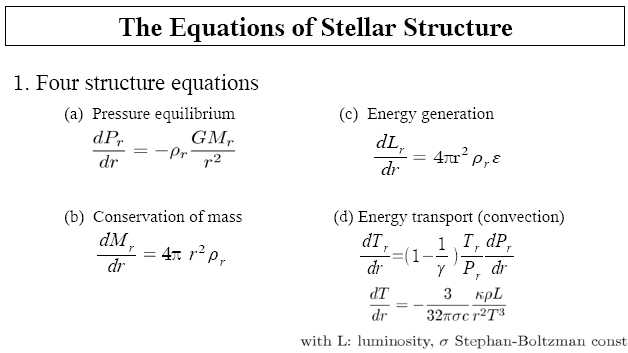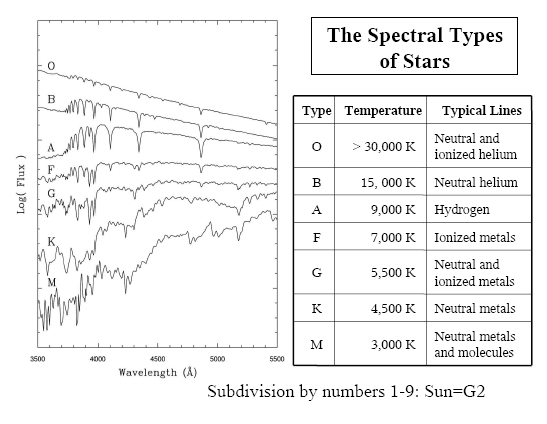Homeworks 12
Review for the Final on 12/11/2009
Mini-Quizzes
Lecture ?
- How long does sunlight take to get to the next star?
- 8 minutes
- How long is a typical galaxy
- 10,000 Lys
- In azimutal coordinates, the positions of star change due to
- the rotation of the Earth
- Peticular velocity is the projected velocity of
- a star relative to other stars
Lecture 6
- Yearly parallax of a star is 0.1 arcsec. What is its distance?
- 10
- The electric and gravitational --- (in Newton's limit) are both scalar
- Absolute magnitude is
- the measure of luminosity of an object
- Light is both particle and wave because otherwise
- atoms would not be stable
Lecture 8
- Besides the radio, ground-based observatories allow to observe in the wavelength range of
- optical to infrared
- By photometry of astronomical object, we measure
- the apparent brightness
- Which of the following effects limit the imaging in reflector telescopes in prime focus?
- spherical aberration
- chroma
- chromatic aberration
Lecture 12
- A white dwarf star is dimmer than a main sequence star of the same temperature by a factor of
- 104
- Radii of white dwarf stars are smaller than main sequence stars by
- 100
- For gray atmospheres the temperature of the black body radiation emitted is equal to temperature atmosphere by depth of
- Electrons can be excited from a lower state j to a higher state i by
- ... photon absorption?
Lecture 15
- Variations in stellar spectra are mainly due to changes of the (pick one):
- stellar radius
- stellar mass
- effective temperature
- none of the above
- Spectra of M stars are dominated by lines of:
- Neutral metals and molecules
- Hot stars show weaker Hydrogen lines in the optical spectra because
- H is mostly ionized
- Cool stars show weaker hydrogen lines in the optical spectra because (pick one):
- Metal lines dominate
- H is mostly...
- Most of the electrons are in the ground state
Lecture 22
- During the main sequence, ... energy is carried by?
- Convection and radiation
- The central density and temperature can be estimated
- Pressure equilibrium and and mass conversation#
- There exists an upper limit for mass of stars (WD, neutral, with an EOS for a degenerate gas P = P rho because the ...
- The solar neutrino problem was resolved by (pick one):
- changing solar mod
- strange neutrinos found
- 3 neutrino flavors found
Lecture 25/26
- All massive stars with M > 8 M⊙ end their life as
- Black hole or neutron star
- The core of an evolved star has a size of about (pick one):
- 1/10 of solar radius
- 1/10 of stellar radius
- 1/100 of solar radius
- 1/1000 of solar radius
- At the end of its life and before the explosion, the core of a 20 M⊙ star shows a shell-like chemical structure of
- Fe, SI, C&O, He
Lecture 28
- What mass fraction of the solar system is in the sun? (pick one)
- 90%
- 99%
- 99.9%
- 99.99%
- The distance of the planets is within (pick one):
- 3 AU
- 30 AU
- 300 AU
- 3000 AU
- Pluto is a planet because (pick one):
- its size and orbit is typical for a Kupiter belt object
- it's larger than the Earth's Moon
- it has a moon
- none of the above
Lecture 32/33
- We know about dark matter because rotational curves are:
- flatter than expected
- Stars in the Galactic Halo are (pick one):
- younger than 1 Gyear
- 1 - 5 Gyrs
- 1 - 12 Gyrs
- older than 12 Gyrs
- The distance to the galactic center (approximately from Earth to the Sun)
- ~10 kpc
Midterm 1
The test consists of a combination of multiple choice questions and other questions which count for 1/3 and 2/3 of the scores, respectively. For partial credit, feel free to add a sentence for the multiple choice questions, and write down the individual steps.
Problem 1A
The proper motion of a star is caused by
- (a) The earth orbiting the sun
- (b) The velocity of the star relative to us
- (c) The orbit of a star within a binary system
- (d) The transverse velocity of the star relative to us
Problem 1B
How are continuum, absorption, and emission line spectra produced? Name the basic types of transitions in an atom. Name one physical process for each of them. Name 2 classes of astronomical objects for each of them.
Problem 2A
Other than the equations for microscopic physics (EOS, nuclear reactions, atomic physics), the basic equations of stellar structure are (mark all which apply):
- (a) Newton's laws
- (b) Pressure equilibrium
- (c) Conservation of mass
- (d) Wave equation
- (e) Momentum transport
- (f) Energy generation
- (g) Energy transport
Problem 2B
Estimate the central pressure and temperature of a main sequence star with 2 M⊙ and 1.8 R⊙ using a one-zone model and the stellar structure equations.
Problem 3A
Suppose two stars 1 and 2 are identical in every respect but star 2 is 100 times further away. If the apparent magnitude of star 1 is 10 mag, the apparent magnitude of star 2 is:
- (a) 0
- (b) 5
- (c) 10
- (d) 15
- (e) 20
Problem 3B
Vega is a bright star in the constellation Lyra with a visual apparent magnitude of 0.03, spectral type A0V, and a parallax of 0.1282 arc sec. What is its distance, absolute magnitude and distance modulus? What is its luminosity (in solar units)? (The absolute visual magnitude of the sun is + 4.85 m. Estimate the effective temperature (hint: Spectral type), and calculate the stellar radius (in solar units).
Given
- Visual magnitude
- Spectral Type = A0V
- Parallax
- Bolometric Correction
- Stefan-Boltzmann constant Failed to parse (syntax error): {\displaystyle \sigma = 5.67 \times 10^{−8} W \cdot m^{-2}K^{-4}}
Distance D
(in parsec)
Absolute Magnitude M
Distance Modulus
Luminosity
where R is the Stellar Radius
Effective Temperature
because of spectral type A
Problem 4A
A white dwarf star is smaller than a main sequence star of the same effective temperature by a factor of:
- (a) 1
- (b) 10-2
- (c) 101
- (d) 10-4
- (e) 10-3
Problem 4B
A spectroscopic binary star, an Algol star, is seen 'equator on' (inclination 0 degrees). The system has an orbital period of 30 days, and the radial velocity of the center of mass is 42 km/sec. The individual velocities of star 1 and 2 are +92 km/sec and -58 km/sec, respectively. What is the total separation of the system? Assuming spherical orbits, calculate the total mass of the system and the individual masses.
Problem 5A
Two stars A and B have the same temperature, but their absolute brightnesses are 0 and +5 mag, respectively. Star A is brighter than Star B by a factor of:
- (a) 0.01
- (b) 0.1
- (c) 1
- (d) 10
- (e) 100
The answer is NOT (a) or (c)
Problem 5B
What are the spectral types and temperature of stars with the following sets of absorption lines in their spectra.
- (a) Ionized and neutral helium lines
- (b) Strong hydrogen lines and weak or no lines of other elements
- (c) molecular bands and neutral atoms.
Explain why the corresponding lines dominate in case (a), (b), and (c), respectively.











